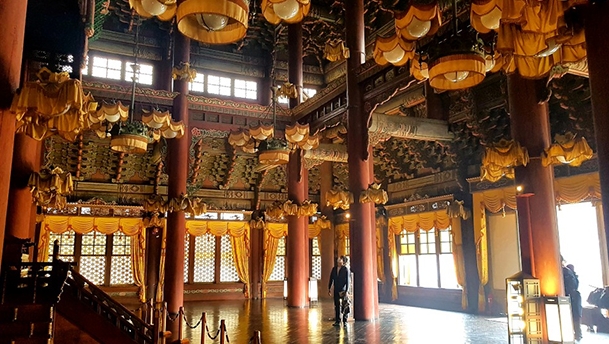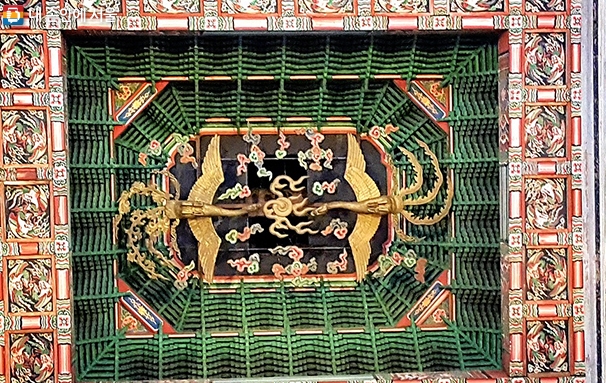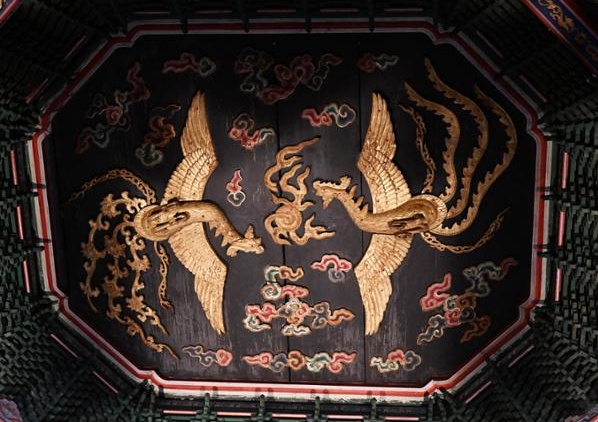Changdeokgung and thr Injeongjeon, a UNESCO World Heritage site in Seoul, South Korea, is renowned for its beautiful traditional Korean architecture and serene gardens. Built during the Joseon Dynasty, it served as a royal residence and administrative center. Visitors can explore its intricate halls, pavilions, and secret gardens, experiencing a glimpse of Korea’s rich cultural heritage and royal history.
Visiting the interior of Injeongjeon Hall offers a captivating glimpse into Korea’s rich cultural heritage. As the main throne hall of the palace, it holds significant historical importance, serving as the site of important ceremonies and royal audiences during the Joseon Dynasty. Its architectural design embodies traditional Korean aesthetics, showcasing intricate wooden structures and vibrant colors.
Inside, visitors can immerse themselves in the ambiance of royal authority and grandeur, gaining insight into the governance and rituals of Korea’s past rulers. Additionally, the hall’s serene atmosphere provides a peaceful retreat from the bustling city, allowing visitors to appreciate the palace’s tranquil beauty and architectural mastery. Overall, exploring Injeongjeon Hall offers a unique opportunity to connect with Korea’s history and culture in a profound and memorable way.

From March 1 to March 31, the Changdeokgung Palace Management Office of the Palace Relics Headquarters of the Cultural Heritage Administration will offer tours of the interior of Injeongjeon, Changdeokgung Palace’s crowning pavilion, in addition to existing interpretation programs.
This is the main pavilion of Changdeokgung Palace, a World Heritage Site, will be open to the public for inside viewing in March. Injeongjeon, a national treasure, has hosted important and official ceremonies such as the king’s coronation, greetings from his subjects, and the welcome of foreign envoys. The outside appears to be two levels; however, the interior is one story with an open top and bottom. Two wooden phoenix sculptures were suspended amid clouds in the center of the one-tiered ceiling to emphasize the space’s magnificent grandeur.
The name of Injeongjeon comes from ‘Injeong (仁政)’, which Mencius mentioned while emphasizing royal politics. As the name suggests, it contains the will to realize good politics based on benevolent politics.

Deep inside, there is a throne that serves as the king’s seat, and behind it is the Ilwolobongdo, which portrays the sun, moon, and five peaks, signifying all that the king rules over. After King Sunjong moved to Changdeokgung Palace in 1907, Injeongjeon was restored, with new electric lighting, glass windows, and curtains installed, as well as flooring replacing Jeondol (baked clay bricks). The palace was in a transitional phase, with modern components added.
This program, which provides a closer look at the inside of Injeongjeon, which is normally only visible from the outside, is held every Wednesday and Thursday in each language (Korean, English, Japanese, and Chinese) in conjunction with the regular commentary on the current Changdeokgung Palace rooms. Every Friday, Saturday, and Sunday, it is accompanied by the in-depth commentary show ‘Looking Deeper into Changdeokgung Palace, Gwolnaegaksa’, which takes viewers on a tour of the Gwolnaegaksa.
To protect cultural heritage and provide a pleasant viewing environment, admission is limited to 20 people at a time. On Wednesdays and Thursdays, 20 people can enter sequentially on site for existing regular commentary visitors, and on Fridays, Saturdays, and Sundays, ‘View in depth at Changdeokgung Palace, Palace Cabinet Temple’ is open to those who make advance reservations (15 people) and on-site registration (for seniors over 65 years old, entry is limited to 5 people per synagogue on a first-come, first-served basis).
In case of rain, the internal tour of Injeongjeon will be canceled to protect the wooden cultural heritage, but the existing commentary program will proceed as scheduled. The participation fee is free, and reservations through the Palace Ruins Headquarters integrated reservation website are required. Link
If you are looking for a complete tour guide about Changdeokgung Palace, please refer to this article.

